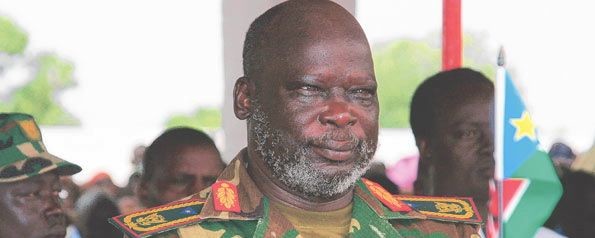The Sudan People’s Liberation Movement (SPLM) has been at the forefront of Southern Sudanese politics since 1983, when it was formed by the late Dr John Garang to fight the government in Khartoum during Sudan’s Second Civil War. The current civil war has seen the rise of three distinct factions, while a remnant of the movement also survives in north Sudan.
Who are these groups and what are they trying to accomplish?
SPLM-Juba – The Juba-based faction is the one headed by President Salva Kiir, who succeeded John Garang as chairman after the latter’s death in 2005. He was confirmed as chairman of the then-united party in a vote at the 2008 convention, but delayed the convening of a planned 2013 convention where his chairmanship would have come up for vote again.
Like its rival SPLM-IO, the Juba faction refers to itself simply as ‘SPLM,’ considering itself the true SPLM. Currently, the SPLM-Juba is trying to maintain Kiir’s government after the uprising by SPLM-IO. Its loyalists include the current cabinet members and vice president.
SPLM-IO – The SPLM-in-Opposition is led by South Sudan’s ousted vice president Riek Machar and includes dozens of defected generals and other former party leaders, mainly from the Nuer ethnic group but also including a few prominent Equatorians and Dinkas.
The faction formed in December 2013 as numerous military units began defecting in Unity, Jonglei, Upper Nile, Central Equatoria and elsewhere, after fighting between Machar and Kiir’s bodyguards in Juba. SPLM-IO wants President Kiir to step down and they are negotiating in Addis Ababa to take part in a transitional government.
SPLM-G11 – The faction known as the ‘Group of 11’ comprises eleven top SPLM officials whom President Kiir arrested after South Sudan’s civil war began on 15 December. This group is led by former SPLM Secretary-General Pagan Amum, and includes also ex-ministers John Luk, Deng Alor and Kosti Manibe, and former governor Chol Tong, among others. President Kiir accused the eleven of attempting a coup, but all eleven were eventually released.
Though the eleven were seen as sympathetic to Machar’s concerns prior to 15 December, they have not joined his SPLM-IO and are instead taking part in peace talks as a ‘third bloc’. Among their supporters is Rebecca Nyandeng Garang, the widow of John Garang. They do not claim to control troops on the ground, but instead have been active primarily in regional capitals Nairobi and Addis Ababa. Mediators also refer to them as ‘SPLM Leaders’ of ‘Former Detainees’.
SPLM-G7 – This now defunct term refers to the same group as the SPLM-G11 but was used occasionally in early to mid-2014 to describe the first group of seven detainees released by Kiir in late January, while the ‘Group of Four’ (Pagan Amum, Oyai Deng, Majak d’Agoot and Ezekiel Gatkuoth) remained on trial for treason in Juba until late April.
SPLM-N – The SPLM-North is a group that split from SPLM in 2011 after the independence of South Sudan and continues to fight to overthrow the government in Khartoum, controlling some territories in Blue Nile and South Kordofan. The father of the group’s Nuba Mountains branch, the late Yusif Kuwa, was a close advisor to SPLM founder John Garang and he chaired the first SPLM national convention held in South Sudan in 1994.
In the current conflict in South Sudan, some SPLM-N troops have been documented fighting against Machar’s SPLM-IO, but the political orientation of the movement is still primarily northward, and their leader Malik Aggar also chairs the umbrella coalition the Sudan Revolutionary Front, which includes several Darfur rebel movements.
SPLM-DC – The SPLM-Democratic Change is a South Sudanese political opposition party led by Upper Nile politician Lam Akol. Before the formation of Machar’s SPLM-IO, Akol’s party was the largest opposition party in the country, and won about 7% of the vote in the 2010 elections.
But in the two years after independence 2011-2013 the party leader went into exile and returned only after a controversial ‘pardon’ by the South Sudanese president for alleged links to insurgents. Though he has not formally joined the government, Lam Akol aligned himself with government negotiators (of SPLM-Juba) at peace talks in Addis Ababa earlier this year.
One month ago, the SPLM-DC absorbed another political party, the South Sudan Democratic Forum.
Historical factions – SPLM experienced another period of factionalism in the 1990s during Sudan’s Second Civil War. SPLM-Nasir was formed by Akol and Machar in 1991 to overthrow Garang’s leadership of the SPLM and received support from Sudan’s government in Khartoum. Garang’s SPLM was termed SPLM-Torit to differentiate it from SPLM-Nasir.
SPLM-Nasir eventually dissolved into various smaller factions, most of which rejoined with Garang’s SPLM prior to the Comprehensive Peace Agreement in 2005 that ended the civil war.
File photo: The late SPLM founder John Garang de Mabior
Related:
SPLM intra-party dialogue resumes in Addis Ababa (23 April)
Pagan says ‘equal stakeholder’ to government in S Sudan talks (15 May)
Analysis: Political dimensions of the South Sudan crisis (5 March)




